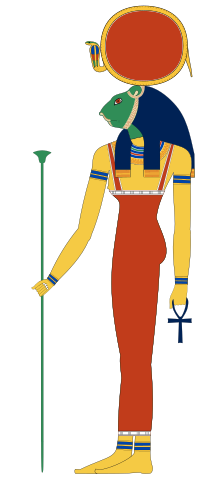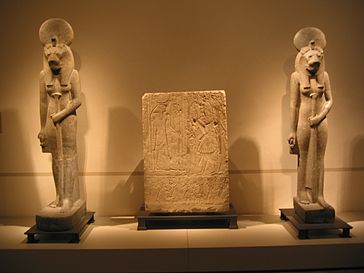Sekhmet
Sejmet (/ˈsɛkˌmɛt/), Sekhmet, Sacmis or Nesert (/ˈsækmᵻs/) was a Egyptian goddess, symbol of strength and power. She was considered the goddess of war and revenge, but also the goddess of healing. It was said that her breath created the desert. She was the protector of the pharaohs and guided them in war.
His cult was so widespread in Egyptian culture that when the first pharaoh of the 12th Dynasty, Amenemhat I, established the capital at Itjtawy, his main cult also moved there.
Sekhmet is also considered a solar goddess, recognized on many occasions as the eldest daughter of the solar god Ra and related to the goddesses Hathor and Bastet.
Iconography
She was represented with the body of a woman and the head of a lioness, although with long hair, generally crowned with the solar disc, the uraeus (serpent goddess Uadjet) that related her to royalty, carrying the Ankh, a papyrus or lotus flower, and arrows. She sometimes also with the Eye of Horus. Her clothing used to be red, representing blood and many times she appears showing her breasts, a symbol of power.
Mythology
She was the eldest daughter of the god Ra, her husband was Ptah and her son, Nefertum with whom they formed the so-called triad of Memphis. She is considered an "alter-ego"; of Hathor, with whom she is frequently identified, and most notably with the cat goddess Bastet, who was considered a "sweet" way; from Sekhmet, when she is she was not angry.
Her wrath was fearsome, but if appeased, she gave her worshipers dominance over their enemies and the vigor and energy to overcome weakness and disease.
In some cases she was considered an ally and protector of Ra, since she killed those who dared to confront or attack the divine or earthly monarchy.
Worship
She was venerated as "Lady of Asheru", in the temple of Mut, in Karnak. She also in Luxor, Memphis, Letópolis and the Delta region. In some temples she was offered the blood of sacrificed animals in order to avoid her anger.
The priests performed a ritual before a different statue of the goddess each day to appease her anger. This is the reason why so many images of the goddess have been preserved. Most of the statues do not show any expression or dynamism (typical hieratism in Egyptian art), they were made in this way thinking that they would last a long time. It is thought that there were more than 700 statues of Sekhmet in the Temple of Amenhotep III. There were even some tame lions in the temples dedicated to Sekhmet in Leontopolis.
Festival of Drunkenness
Ra was enraged that humanity rebelled against him, so he sent his daughter Sekhmet to teach them a lesson. Sekhmet slaughtered people until the Nile was red with so much blood. Ra worried that her daughter would extinguish all of humanity, and she grew thirsty for blood from her. Seeing this, Ra dyed beer with red ocher or hematite to make it look like blood and Sekhmet, thinking that the beer was blood, became so intoxicated that she could not continue killing it and returned to Ra. One version says that three days after she was drunk, Sejmet transformed into Hathor and humanity was safe.
At the end of a battle, festivals were held in honor of Sekhmet to appease her from destroying again. During an annual festival held at the beginning of the year, called the Festival of Drunkenness, the Egyptians danced to the sound of music to mitigate the bravery of the goddess and drank large amounts of wine to imitate, according to the myth explained, the drunkenness that stopped to the goddess and her wrath to destroy humanity. They also thought that she served to prevent the floods that occurred at the beginning of the year, when the Nile was dyed red by silt and Sejmet quelled the floods by drinking the water and saving humanity.
In 2006, Betsy Bryan, an archaeologist at Johns Hopkins University, discovered while excavating in the temple of Mut drawings of priests and citizens participating in this hugely important festival. Historical records have been found showing that thousands of people participated in the festival. These discoveries were found in the temple of Mut because when Thebes was established as the capital, Mut retained some hallmarks of Sekhmet. These temple excavations at Luxor revealed a "place of drunkenness" The temple was built by Queen-Pharaoh Hatshepshut during the height of her reign.
Sekhmet was also considered the mother of Maahes, a deity that appeared in the New Kingdom.
Epithets
She was known as "The great mother goddess", "The most powerful", "The invincible", "The terrible", for his violent nature. The "Lady of the West", "The great lady loved by Ptah and mother of Nefertum", the "Goddess of war", the "Lady of the mountains of the west", "The one that stops the darkness" in the funerary aspect of it. She was called a "magic expert" as a healer. The & # 34; Goddess of love & # 34;, because she provoked passions. The & # 34; Sovereign of the desert & # 34;, & # 34; The perfect & # 34;, since she had all the qualities for being the firstborn of the great Ra and therefore makes her a great pharaoh queen.
| Sejmet in hieroglyphic |
|
Contenido relacionado
Colonialism
Taifa art
Carlos Martel


